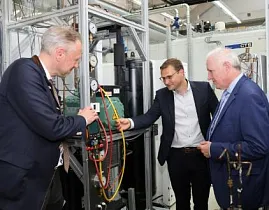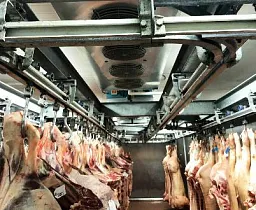Researchers from the UK and Spain have identified an eco-friendly solid that could replace the inefficient and polluting fluids used in most refrigerators and air conditioners.
When put under pressure, plastic crystals of neopentylglycol (NPG) yield huge cooling effects—sufficient to make them competitive with conventional liquid coolants. In addition, the material is inexpensive, widely available and functions at close to room temperature.
Details are published in the journal Nature Communications.
The fluids currently used in the vast majority of refrigerators and air conditioners—hydrofluorocarbons and hydrocarbons (HFCs and HCs)—are toxic and flammable. When they leak into the air, they also contribute to global warming.
“Refrigerators and air conditioners based on HFCs and HCs are also relatively inefficient,” said Dr Xavier Moya, from the
University of Cambridge, who led the research together with Professor Josep Lluís Tamarit from the Universitat Politècnica de Catalunya. “That’s important because refrigeration and air conditioning currently devour a fifth of the energy produced worldwide, and demand for cooling is only going up.
To solve these problems, materials scientists around the world have sought alternative refrigerants that are solids. Moya, a Royal Society Research Fellow in Cambridge’s Department of Materials Science and Metallurgy, is one of the leaders in this field.
In their newly-published research, Moya and collaborators from the Universitat Politècnica de Catalunya and the Universitat de Barcelona describe the enormous thermal changes they achieved by putting plastic crystals under pressure.
Conventional cooling technologies rely on the thermal changes that occur when a compressed fluid expands. Most cooling devices use fluids such as HFCs and HCs. As the fluid re-expands, its temperature drops, cooling its surroundings.
With solids, cooling is achieved by changing the material’s microscopic structure. This change can be achieved by applying a magnetic field, an electric field or a mechanical force. Despite decades of work, the caloric effects achievable with a variety of solids have fallen far short of the thermal changes available in fluids. The discovery of colossal barocaloric effects using a plastic crystal of neopentylglycol, and other related organic compounds, has levelled the playing field.
Due to the nature of their chemical bonds, organic materials are easier to compress. In addition, NPG is widely used in the synthesis of paints, polyesters, plasticisers and lubricants. It’s not only widely available, but also is inexpensive.
NPG’s molecules, composed of carbon, hydrogen and oxygen, are nearly spherical and interact with each other only weakly. These loose bonds in its microscopic structure permit the molecules to rotate relatively freely.
The word “plastic” in “plastic crystals” refers not to its chemical composition but rather to its malleability. Plastic crystals lie at the boundary between solids and liquids.
Compressing NPG yields unprecedentedly large thermal changes due to molecular reconfiguration. The temperature change achieved is comparable with those exploited commercially in HFCs and HCs.
The discovery of colossal barocaloric effects (CBCE) in a plastic crystal should bring barocaloric materials to the forefront of research and development to achieve safe environmentally friendly cooling without compromising performance.
Moya is now working with Cambridge Enterprise, the commercialisation arm of the University of Cambridge, to bring this technology to market.





